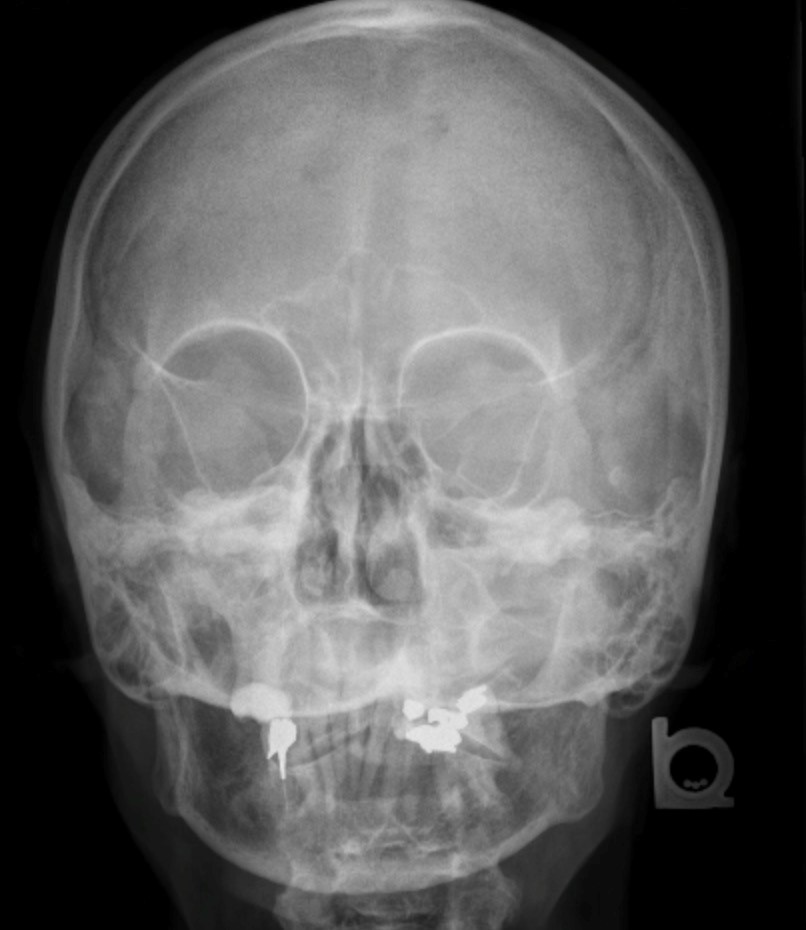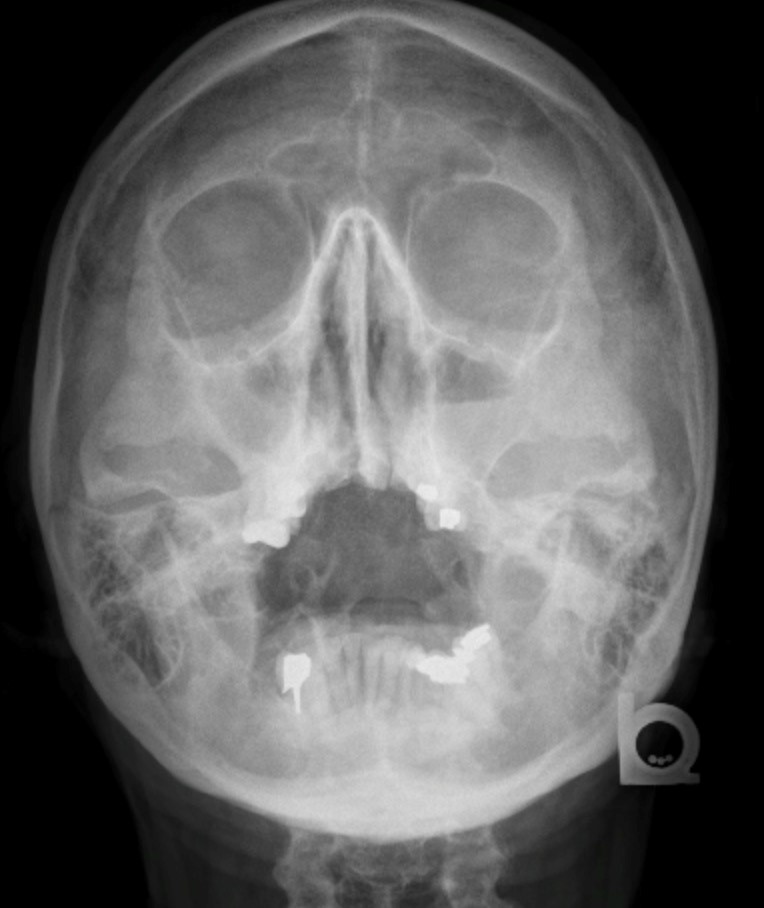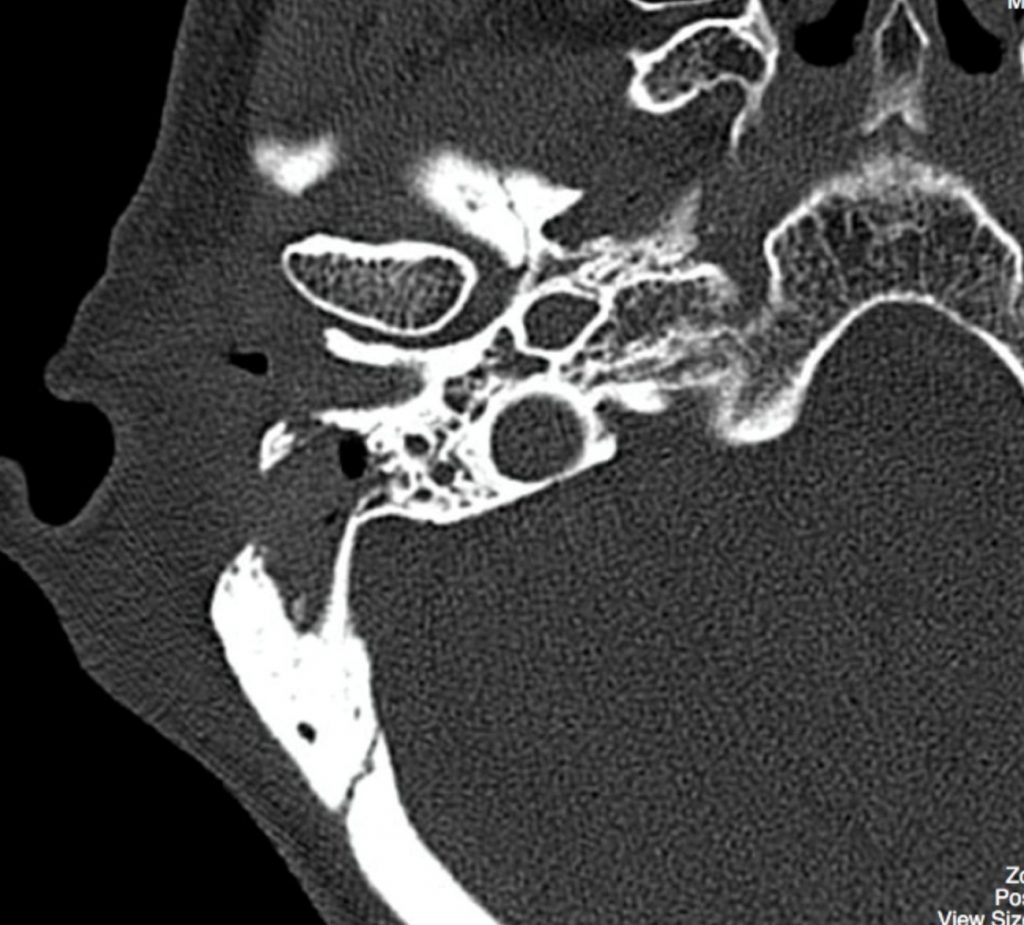Chapter 12 – Head and Neck
Sinusitis/Mastoiditis
Case 1
Sinusitis
Clinical:
History – Long-term congested sinuses and sinus pain.
Symptoms – The patient complained of bilateral maxillary sinus fullness for 8 weeks despite a course of antibiotics. She had thick, green mucus from her nose.
Physical – The maxillary antra were tender bilaterally.
DDx:
Allergic Sinusitis
Infectious Sinusitis
Nasal Polyps
Imaging Recommendation
X-rays of the Paranasal Sinuses are not usually required unless symptoms persist for longer than 4 weeks while on treatment.
CT scanning is best utilized for chronic sinusitis to rule out anatomic deformity of the sinus drainage pathways.


Imaging Assessment
Findings:
The maxillary antra were opacified bilaterally. There was an air-fluid level in the left maxillary antrum. The other sinuses were clear.
Interpretation:
Allergic or infectious sinusitis.
Diagnosis:
Sinusitis
Discussion:
Each of the four paranasal sinuses is connected to the nasal cavity by narrow tubes (ostia), 1 to 3 mm in diameter; these drain directly into the nose through the turbinates. The sinuses are lined with a ciliated mucous membrane (mucoperiosteum).
Pathophysiology:
- Acute viral infection: Infection with the common cold or influenza
- Mucosal edema and sinus inflammation
- Decreased drainage of thick secretions/obstruction of the sinus ostia
- Subsequent entrapment of bacteria
- Multiplication of bacteria
- Secondary bacterial infection
Imaging findings may include:
- Overall, standard radiographs are of limited use in diagnosis, although negative films are strong evidence against the diagnosis.
- CT scans:
- Much more sensitive than plain radiographs in detecting acute changes and disease in the sinuses.
- Recommended for patients requiring surgical intervention, including sinus aspiration; it is a useful adjunct to guide therapy.
Case 2
Mastoiditis
Clinical:
History – Recurrent otitis media, right.
Symptoms – The soft tissues behind the right ear were very painful.
Physical – The soft tissues behind the right ear were red and swollen, there was also a sense of bogginess in the tissues. This area was very tender.
DDx:
Mastoiditis
Malignancy of the Mastoid region.
Cellulitis
Imaging Recommendation
CT Scan of the Skull Base and Mastoid Region


Imaging Assessment
Findings:
The aeration of the right mastoid air cells was diminished. There was destruction of the bone of the lateral aspect of the right mastoid. There was a soft tissue and fluid containing mass behind the right pinna. No intracranial or middle ear abnormalities.
Interpretation:
Mastoiditis/Abscess
Diagnosis:
Mastoiditis/Abscess
Discussion:
Mastoiditis is inflammation of the mastoid process and air cells, a complication of otitis media.
Initial hyperemia and edema of the mucosal lining of the air cells result in accumulation of purulent exudate.
Dissolution of calcium from the bone of the septa of the air cells and osteoclastic activity in the inflamed periosteum lead to bone necrosis and coalescence of air cells.
Most common bacterial isolates are:
- Streptococcus pneumoniae
- Streptococcus pyogenes
- Haemophilus influenzae
- Moraxella catarrhalis
- Staphylococcus aureus
Imaging findings may include:
- Plain x-rays of the mastoid region may demonstrate clouding or opacification in areas of pneumatization.
- CT scan can demonstrate early involvement of bone (mastoiditis with bone destruction).
- MRI is more sensitive than CT scan in evaluating soft-tissue involvement and is useful in conjunction with CT scan to investigate other complications of mastoiditis.
Attributions
Figure 12.4A X-ray of the facial sinuses demonstrating opacity of the maxillary sinuses by Dr. Brent Burbridge MD, FRCPC, University Medical Imaging Consultants, College of Medicine, University of Saskatchewan is used under a CC-BY-NC-SA 4.0 license.
Figure 12.4B X-ray of the facial sinuses with maxillary opacity and a left air-fluid level by Dr. Brent Burbridge MD, FRCPC, University Medical Imaging Consultants, College of Medicine, University of Saskatchewan is used under a CC-BY-NC-SA 4.0 license.
Figure 12.5A CT Scan of the head revealing mastoid air-cell opacity and skull erosion by Dr. Brent Burbridge MD, FRCPC, University Medical Imaging Consultants, College of Medicine, University of Saskatchewan is used under a CC-BY-NC-SA 4.0 license.
Figure 12.5B CT Scan of the Mastoid with air-cell opacity and skull erosion by Dr. Brent Burbridge MD, FRCPC, University Medical Imaging Consultants, College of Medicine, University of Saskatchewan is used under a CC-BY-NC-SA 4.0 license.

